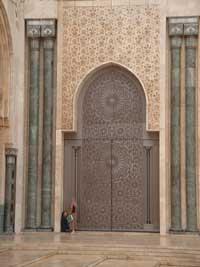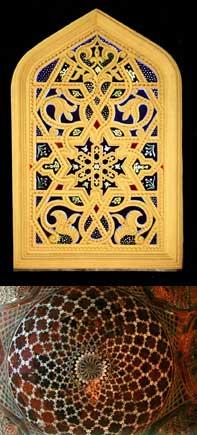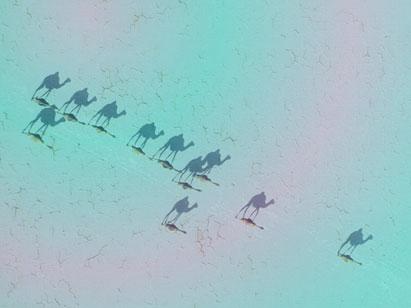Man who fell in love with a window
2002/11/17 Roa Zubia, Guillermo - Elhuyar Zientzia

One night Alhei had a strange dream, much rarer than she used to have: an old woman asked him three times what was the most beautiful thing in the world. They asked the advisors and they discovered the meaning of their dream; the ninety anniversary of Al-hali's First Woman was coming soon and asked for a gift in their dreams. He agreed with Alhal. Both were happy in the years they spent together, so the First Woman deserved the most beautiful in the world.

Although they interpreted their dream, the advisors were not able to answer the question. Much was discussed. They withdrew to reflect. Dreams also attempted to find answers. For one, the most beautiful thing in the world was the white elephant, another thought it was the emerald sea water. But all these things were far away and there was no time to bring them.
Al, desperate, took a camel and entered the desert for answers. Her first Woman did not tell her why she had thrown herself, so she sent her maid following Alhal.
When the maid returned home, she told her First Woman what she saw. In the desert, Al-hali found a genius, asked him a question and in return gave him a camel. As the maid was far away, she did not hear the interview, but Alhal left the neighboring town very satisfied. When she entered a spectacular house in that village, the maid approached and from the outside window she heard Al-hali's voice: "From Orin the time has not come to make a great gift to his First Woman." Having heard all this, the First Woman, angry, cut off the maid's head with a zimitarra.
Artist's House
Islam forbids the faithful to imagine animals or people. Consequently, mulsulmans have worked for centuries geometric figures. Al-daharej was dedicated to it, so he was a very popular man in the village. He was an artist, a builder, but he did not work with his hands, but with numbers. From a couple of numbers he combined geometric figures to make spectacular window grids.

This drawing was given to the carpenter servant, who turned the design into a piece of wood. As the desert genius himself told Al-hali, these works were the most beautiful in the world. Kings and emperors everywhere asked Al-dahareji for one of those ornaments.
He realized the wisdom of the artist and asked him to teach him how to design those. Al-daharejo did not care to show the work system, as this type of grid required years to learn to do well.
"The hardest thing is to start from there is a recovery effort," Al-daharejo said. Normally it combined two types of symmetries. The twelve-pointed star in the centre, for example, combined it with seven tips at the ends of the design. Halfway through, to link the symmetry of the twelve with that of the seven, he had to invent a transition without symmetry. No symmetry, but elegant.
"I don't understand anything," Al said. "Why do you tell me about symmetry? Not designing a grid for a window? Talk about something else to make windows: that only the artists do." But Al-daharej was a man with patience. While still working, he taught him a beautiful mosaic of the floor.
"Look at that," he said, "The central star tile has five tips and those in the corners, four. I have to put many stones to tie the center with one end. How should they be? To know this I ask symmetry and mathematics. I calculate it.
Now, Al was convinced that that artist was very wise. In the city I used methods that nobody understood and the result was good. Al-daharej's response was representative: "Symmetry and mathematics are wiser than me. That's the secret: you have to ask who knows."
At home

The first Woman did not understand what really happened on that journey. He tried to explain it when he returned to al-hal, but the truth is that the ninety was not an appropriate number to ask symmetry; the ninety-six was much better because it was very easily combined with two, three, four, six, twelve and I don't know how many numbers. Al-daharejo taught Al-hal, a grid of his own to celebrate the ninety-six years much more beautiful than that of celebrating the ninety.
"This man has gone crazy," the First Woman thought. "Do you want more symmetry and math than I do?" Perhaps the beauty of geometry blinded her husband. The First Woman did not understand. As the years progressed, the woman was increasingly concerned.
And the man realized that his first wife died at the age of ninety-five. He realized that Al-hali's unsymmetrical tears soaked the perfect floor adorned with a mosaic.
Published in 7K.

Gai honi buruzko eduki gehiago
Elhuyarrek garatutako teknologia





